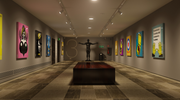
Investing in Art: A guide for beginners
, by PAUL FRAIKUE, 4 min reading time

, by PAUL FRAIKUE, 4 min reading time
Investing in art can sometimes be a gamble instead of an investment. In recent years, the fine art market has received a lot of attention thanks to big-ticket auctions. For example, Jeff Koons' 'Rabbit' sculpture broke records for selling for $91.1million in May 2019 (Gallagher,2020-Forbes).
The global art boom is no fad. The 2019 annual report by Art Basel and UBS Global Art estimates that worldwide art sales surpassed $67 billion last year.
This article will help you weigh the pros and cons of investing in art to help you make sound investment decisions.
Art Investing 101
Research
Similar to any other investment opportunity, extensive research is a must. Before investing in the art market, dedicate a few months to observing art auction news and valuation trends. If you want indent analysis on high-value art pieces and artists, speak to an art specialist who may give you a better understanding.
A typical art rule is that works of prolific living artists are valued lower than deceased master artists with a finite number of pieces attributed to them. Therefore, art produced by dead authors or artists generally sells for more and accrues value faster than art by contemporary artists.
What are the payoffs for art investing?
Purchasing art is a type of investment strategy. It can be a massively profitable venture for the savvy art buyer, as demonstrated by Artprice in its list of the best-performing art stock sales of 2017. This list shows the potential for incredible returns for investing in art. For example, an artwork bought from artist Jim Crow (1986) was sold by its buyer 125 times its original investment after holding on to the piece for about 25 years.
Jaw-dropping returns such as these are why the global fine art market is saturated with buyers looking to capitalize on the next sleeper hit.
"Driven by a growing market of indigenous investors, African art is commanding increasingly high prices at the world's auction houses" - African Business
A painting by the late Ben Enwonwu, widely considered the father of Nigerian modernism, fetched the equivalent of over a million dollars at auction, with his portrait Christine selling for £1.1m ($1.4m) at Sotheby's, London. In 2018, after decades spent furnishing the wall of a north London flat, Enwonwu's masterpiece Tutu was auctioned at Bonhams for £1.2m, a figure way beyond its pre-sale estimate of £300,000 (AfricanBusiness, 2019)
According to Hannah O'Leary, African art should be ready to be making six to seven figures as a standard, whereas 12 months ago or 24 months ago, those prices were really very exceptional.
An internet-driven market has transformed expectations and enabled the works of established names and up-and-coming artists to be disseminated and discussed. A rapid increase in collector class, led by bankers and industrialists from Africa’s biggest economy, Nigeria, and from the rapidly growing economies of Ghana and Senegal, are pushing the market further. In Ghana, the market is benefiting from having one of Africa’s best art schools located in the town of Kumasi and a government actively invested in art promotion.
Check out our African Art collection here
Art Investment Tips as a Beginner
Keep risk in mind
Art is classified as highly illiquid. Make sure you are looking to flip an undervalued art piece to make quick money. It can take years to have an art piece sold at an auction. Therefore, you should consider art investing a medium- to long-term addition to your portfolio.
Diversify your collection by purchasing art from various artists, artistic traditions, and historical periods to mitigate the risks of art buying.
Factor in maintenance and other costs
Owners of such treasures must consider storage, which means providing facilities to maintain the right temperature, humidity, and light at all times to ensure that the work remains in its finest condition.
Know what you want and how much you can spend
There are three types of art you can purchase — originals, prints, and reproductions — and its resale potential is also determined by which of these categories it falls in.
The originals are, as the name suggests, of the highest value. Then comes prints, the best quality of which is known as giclée (zhee-klay). The lesser the number of prints, the higher the value. The value of a giclée may also increase if it bears a fresh signature or an original drawing by the artist in its margin. However, the giclée may not have a resale value. On the other hand, reproductions are mass-produced and are essentially of little to no value.
How much money you can spend, including additional costs that may accrue and losses due to a fall in worth, will have to be factored in the type of artwork you would want to buy. (GUPTA,2021)
Investing in art holds the potential for significant financial rewards. Blue-chip names such as Warhol, Basquiat, Kusama, and Picasso are serious moneymakers in the global art market.
To conclude, art investing isn't for those looking for a get-rich-quick scheme. It takes many years, or even decades, for artwork to appreciate, and there are many responsibilities that fine art owners must commit themselves to. For this reason, art investing is usually reserved for art lovers and enthusiasts.






Subscribe to our emails